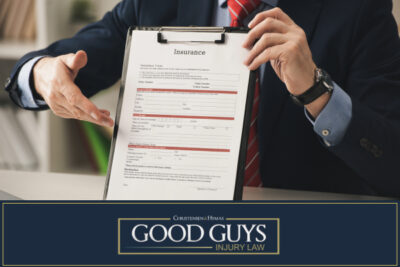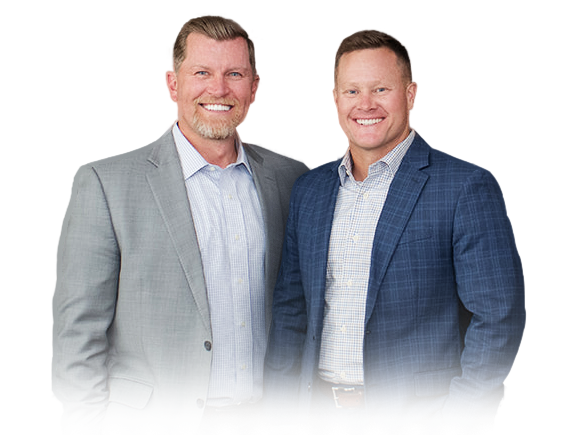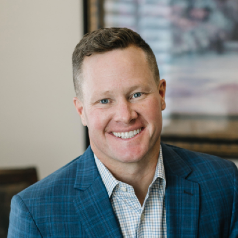
Getting into a car accident is stressful. But it gets even harder when the other driver doesn’t have enough insurance to pay for your injuries and losses. You might have serious damage, but the other person’s policy can’t cover the costs. That’s where underinsured motorist coverage can help.
At Good Guys Injury Law, we’ve seen how confusing this can be. Many people don’t even know what kind of insurance coverage they have until they need it. If you’re in a crash with an underinsured driver, we’ll help you understand what to do. We work to make sure your rights are protected and that you aren’t left with unpaid medical bills or other costs.
We’ll walk you through how underinsured motorist claims work, when to file, and how to avoid costly mistakes. You don’t have to figure it out on your own.
Table of Contents
What Does “Underinsured Driver” Mean?
An underinsured driver is someone who has liability insurance, but it’s not enough to pay for all the damage. They may have the minimum coverage required by law, but it’s still too low for your real losses.
Let’s say your medical expenses and car repairs total $75,000, but the other driver’s policy only covers $25,000. That leaves a $50,000 gap. In that case, your underinsured motorist coverage can help fill the gap (if you have it).
This kind of insurance coverage gives you a financial safety net when the other driver can’t pay everything. But you have to act fast and follow the steps your policy requires. If you’re unsure what your policy includes, we’ll help you find out.
How It’s Different From Uninsured Motorist (UM) Coverage

It’s easy to confuse underinsured motorist coverage with uninsured motorist coverage, but they’re not the same. Uninsured motorist coverage helps when the other driver has no insurance at all. Underinsured motorist coverage applies when they have some, but not enough.
With uninsured motorist coverage, your own insurance company steps in because there’s no other policy to use. With underinsured motorist coverage, you first file a claim with the other driver’s company. Only after that will your coverage come into play if your damages are higher than their limit.
Both types of coverage are important. They protect you from drivers who can’t fully pay for the harm they cause. You may not think you need it until you get into an accident with an uninsured or underinsured driver.
What to Do Right After the Accident
Taking the right steps after a crash can protect your health, your rights, and your ability to file an underinsured motorist claim. These initial actions are especially important when the other driver doesn’t have sufficient insurance coverage.
Call 911 and Get Medical Help Immediately
Your health comes first. Call 911 right away, even if the crash seems minor. Emergency help will come, and a police report will be made. Don’t wait to get checked out. Some injuries don’t show up right away.
If you’re hurt, go to the hospital or visit your doctor as soon as you can. Delaying medical treatment can hurt your health and your claim. Make sure to keep track of all medical bills, visits, and care instructions. These will help show the cost of your injuries later.
Even if you don’t feel hurt, getting checked keeps you safe. It also gives you a record that can support your insurance claim.
Gather Evidence at the Scene
If you’re able, take photos and videos at the accident scene. Get pictures of the cars, damage, skid marks, traffic signs, and any visible injuries. If the other driver’s car shows signs of damage, take close-up shots.
Ask for the names and contact details of any witnesses. If someone saw what happened, their story can help your case later. The more proof you have, the better. All of this evidence helps show what happened and can be key when filing an underinsured motorist claim.
Request a Police Report
Make sure the police come to the accident scene and file a report. This official document gives a detailed account of the crash. It may also list the other driver’s insurance and if they broke any traffic laws.
You can ask for a copy of the report from the police department. This report is strong evidence for dealing with an insurance company. It also supports your claim if you need to go to court. If the other driver has little or no liability coverage, the report may help prove your right to file under your underinsured motorist coverage.
Notify Your Insurance Company Promptly
Tell your own insurance company about the accident as soon as you can. Waiting too long could hurt your claim. Some policies have short deadlines for reporting an accident with an uninsured or underinsured driver.
When you report the crash, give clear facts. Don’t guess or assume blame. Let your insurer know that you may be filing an underinsured motorist claim, depending on what you learn about the other driver’s policy. Early notice helps your insurer prepare and shows that you followed the rules. It also keeps your underinsured motorist coverage ready if you need it.
How Underinsured Motorist (UIM) Coverage Works

When the other driver doesn’t have enough insurance coverage to fully pay for your losses, your own underinsured motorist coverage can step in to help. But it only works if you follow your policy and file things correctly.
What UIM Insurance Covers
Underinsured motorist coverage is designed to protect you when the other driver’s liability insurance doesn’t cover all your losses. For example, if your medical bills, car repairs, and lost wages add up to more than what the other driver’s insurance pays, your UIM coverage may help make up the difference.
It can help cover a wide range of damages, including medical expenses, pain and suffering, and car damage. But UIM doesn’t cover everything automatically. It will only pay what’s left over after the other driver’s policy maxes out. If you want to use it, you need to show that your damages go beyond their policy limit.
When UIM Applies
Your underinsured motorist coverage comes into play only after the at-fault driver’s liability coverage has been fully used. That means you must file with their insurance company first. Only if their payment doesn’t cover all your losses can you file a claim under your UIM.
UIM coverage is especially helpful when the uninsured or underinsured driver causes serious damage. If your costs are high and the other driver only carries the state minimum insurance, your own policy helps close the gap. It gives you the chance to recover the rest without having to sue the uninsured driver personally. If your damages are higher than the at-fault driver’s coverage, then your UIM kicks in to cover the remaining losses.
Filing a Claim Through Your Own Policy
To use your UIM coverage, you’ll need to open a claim with your own insurance company. This doesn’t mean they’ll automatically pay right away. You’ll need to show that the other driver’s coverage was not enough and that your losses are still unpaid.
Start by giving your insurer proof, such as medical records, the police report, and any documents that show how much money the car accident has cost you. You’ll also need to give them a copy of the at-fault driver’s insurance offer to show that it wasn’t enough.
Filing an underinsured motorist claim is like filing any other insurance claim, but it’s more detailed. You’ll likely have to talk to insurance adjusters, give updates, and maybe even go through negotiations before getting paid.
Steps to File a UIM Claim

Filing an underinsured motorist claim takes a few important steps. These steps help protect your rights and improve your chances of getting the full compensation you deserve after a car accident with an underinsured driver.
Check Your Auto Insurance Policy
Before doing anything else, take a close look at your auto insurance paperwork to make sure you actually have underinsured motorist coverage. Not all drivers carry it — it’s optional in some states — so it’s best to confirm before moving forward.
Look for the part of your policy that lists your UIM coverage limits. That number tells you the most your own insurance company will pay if the other driver’s insurance is too low. If you’re not sure what the numbers mean, your insurance agent or a car accident lawyer can explain it to you. Understanding your coverage ahead of time will help you avoid delays when you’re ready to file.
File a Claim With the At-Fault Driver’s Insurer First
Even if you know the underinsured driver who hit you doesn’t have enough coverage, you still have to file a claim with their insurance company first. This is the only way to prove their liability insurance isn’t enough to cover all your costs.
This step must occur before you can use your underinsured motorist coverage. The other driver’s insurer will make a settlement offer based on their policy limits. Once you get that offer, you can compare it to your total losses. Only after you accept their full limit (and it’s still not enough) can your policy step in to help cover what’s left.
Notify Your Insurer That You Plan to Use UIM Benefits
After you’ve accepted the full payout from the other driver’s policy, let your own insurance company know that you plan to file an underinsured motorist claim. Tell them you’ve received all you can from the at-fault driver’s insurance coverage, but your losses are still higher.
Do this as soon as possible. Waiting too long could risk missing deadlines that may be written into your policy. You may also need to get written permission from your insurer before signing any release forms from the other driver’s company. This helps protect your right to use your UIM benefits and avoids any coverage issues later.
Provide Documentation of Your Total Losses
Your own insurance company will ask for solid proof of your damages. That means you’ll need to gather all your medical bills, repair estimates, receipts, and anything else that shows what the car accident has cost you.
Include things like missed paychecks if you had to take time off work, future medical expenses if you still need treatment, and any evidence of pain and suffering. The more proof you have, the stronger your underinsured motorist claim will be. Be honest, clear, and detailed when you share this information with your insurer.
Be Prepared for Negotiations With Your Insurer
Just because you’re dealing with your own insurance company doesn’t mean they’ll agree with everything you claim. They may try to offer less than what your damages are worth, or argue that some costs shouldn’t be included.
This is why it’s helpful to work with a car accident lawyer if things get complicated. Negotiating can be stressful, especially when you’re still healing. Your lawyer can speak with the insurance adjusters, respond to low offers, and help push for a fair amount. It’s not always easy, but it’s often the only way to get the full compensation you deserve.
FAQs
Will my health insurance cover medical expenses after a car accident?
Yes, your health insurance may help cover medical expenses after a crash, but it often comes with deductibles, co-pays, and limits. It also may not pay for all treatments, especially if they believe the other driver should be responsible. You may also have to pay your health insurer back later if you receive money from a settlement.
What is personal injury protection, and do I need it if I have health insurance?
Personal injury protection (PIP) is extra insurance coverage that pays for your medical bills, lost wages, and other costs after an accident, no matter who caused it. Even if you already have health insurance, PIP can be helpful. It kicks in quickly, may cover things your plan doesn’t, and doesn’t require a long claims process with the other driver’s insurance.
If I don’t have underinsured motorist coverage, who pays my medical costs?
If you don’t have underinsured motorist coverage, you may need to rely on your health insurance and personal injury protection, or you may even have to pay some costs yourself while your claim is being handled. In some cases, you may be able to sue the other driver personally or find other parties who could share responsibility.
Can I still get help with bills if the other driver has insurance, but not enough?
Yes. If the other driver’s insurance doesn’t fully cover medical expenses, you can file a claim under your underinsured motorist coverage. This helps you recover the difference between what you’ve lost and what the other driver’s policy paid.
What should I do first if I’m hurt and worried about medical costs?
Start by getting medical care right away, even if you’re unsure how you’ll pay. Keep all bills and records. Then, call your insurance company and ask what options you have, including personal injury protection or health insurance. If the costs are high and you’re not getting the coverage you need, talk to a car accident lawyer for help.
Call Our Utah Personal Injury Lawyer for a Free Case Consultation

Being in a crash with an underinsured driver can leave you stuck with bills and stress you didn’t expect. You might have serious injuries, car damage, and high medical expenses, but the other driver’s insurance isn’t enough to pay for it all.
That’s where we come in. At Good Guys Injury Law, we help you figure out your rights and options. Our team has handled many underinsured motorist claims, and we know how to deal with your insurance company when they push back or delay payment.
We’ll go over your coverage, explain the process in plain English, and help you build a strong case. Whether you’re using personal injury protection, health insurance, or filing a claim against the other driver, we make sure no step is missed.
Call us today for a free case consultation. There’s no pressure, just helpful answers and honest support when you need it most.






